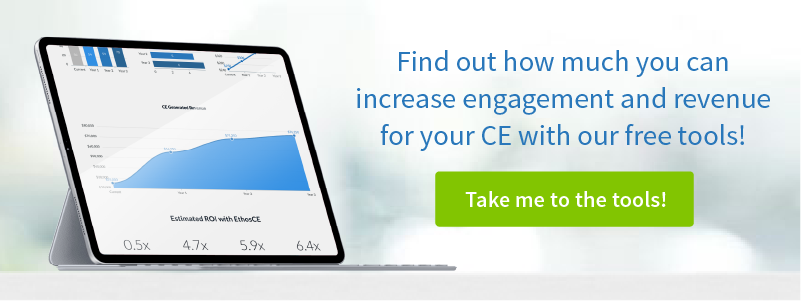Can You Recognize the Most Business-Critical Feature of Your LMS?
I recently wrote about web services for CME and explained why it mattered to CME providers and physicians. In today’s post let’s look at why an LMS’ web service is perhaps the most business critical feature to the educational provider.
What is a web service?
 Web services are use to share information between LMS, AMS, CRM and marketing systems.
Web services are use to share information between LMS, AMS, CRM and marketing systems.Let’s review what a web service is before getting started. A web service is a form of communication between software systems that uses the web’s HTTP protocol (the same one you used when you loaded this web page). And because the web is everywhere, this means that web services are ubiquitous. Your phone, router, DVR, smartwatch, travel reservations, online bank, Facebook, Instagram etc., all probably use web services to communicate with each other when necessary..
Web services, using HTTP, allow systems to create, retrieve, update and delete data without human intervention. For example, when you purchase something online, your purchase information is passed from the online store to a payment gateway to the payment processor and back using web services.
That technology is what makes it possible for all your systems to work together to provide education to your customers and members. Without it, your LMS is an island. Let’s looks at some use cases.
Enrolling a learner from an association management system (AMS)
A common use case is when an AMS needs to enroll a member in an e-learning course.
AMS: “Hi LMS. Here are my credentials. Enroll user 12345 in course ABCD”
LMS: “Hi. I recognize your credentials and trust you. I confirm I have enrolled user 12345 in course ABCD.”
Notice how the request made by the AMS is self-contained, i.e., it doesn’t rely on anything else happen. This is by design. HTTP is a “stateless” protocol, which means each request and response are self contained.
Sharing user profile details
The LMS needs to know information about the learner that is stored in the AMS. For example, if they have a role that gives them special pricing.
LMS: “Hi AMS. Here are my credentials. Tell me about User ID 12345.
AMS: “I recognize your credentials and trust you. User ID 12345 has the following information. Name: Jane Doe; Role: Retired member.”
The LMS can now update the user’s role from “active” to “retired” and the learner will receive the “retired member” pricing.
Email and inbound marketing
Many organizations providing e-learning use marketing tools provided by vendors such as Hubspot, Sailthru, Adrack, Marketo, and others to market education and courses to customers.
In this use case, the LMS reports on which courses learners are looking at to the marketing system.
LMS: “Hi marketing system. Here are my credentials. User 12345, Dr. Jane Doe, just looked at course ABCD containing the following data: Name: Hepatitis C management; Topics: infection, antivirals, HCV, hematology, GI, screening”
Marketing system: “I recognize your credentials and trust you. I confirm the information you sent is now stored with user 12345.”
The marketing system can then send an email to user 12345 the next day promoting courses with related topics in which Dr. Doe has not already registered. Not shown here is another web service where enrollments are also shared from the LMS to the marketing system.
Tracking the status of external course content
Some course content can’t be uploaded into the LMS for various reasons. For example, maybe it’s licensed from a third-party provider who isn’t willing to share it. However, the LMS is still responsible for awarding credit and storing all the learning records.
In this use case an external content provider sends information about course content completion to the LMS.
External content provider: “Hi LMS. Here are my credentials. User 12345 just completed the case study content 5678.”
LMS: “I recognize and trust you. I confirm that user 12345 just completed the case study content 5678.”
The LMS can now let user 12345 complete the course, earn credit and download a certificate.
Reporting and customer service
Typically an organization using an LMS has to provide customer service to its members, customers or employees using the LMS.
In this use case, the LMS will send all data about a learner’s activities to a CRM so that the customer service staff can see all of the learners information in a single place.
LMS: “Hi CRM. Here are my credentials. User 12345 just purchased course ACBD for $20.”
CRM: I recognize and trust you. I confirm that User 12345 just purchased course ACBD for $20.”
And then, a while later..
LMS: “Hi CRM. Here are my credentials. User 12345 just completed course ACBD, received a 98% on the assessment, and earned 1 AMA PRA Category 1 Credit.”
CRM: “I recognize and trust you. I confirm that user 12345 just completed course ACBD, received a 98%, and earned 1 AMA PRA Category 1 Credit.”
The next day the customer service representative receives a call from Dr. Doe and she renews her membership. After that’s done Dr. Doe asks, “By the way, how many credits have I earned this year?” Of course Dr. Doe could look up that herself in the LMS, but since she’s on on the phone with the customer service rep, the rep can see that information without having to look in the LMS. Using web services, all of Dr. Doe’s educational history is in one place and the customer service rep can see everything in a single system.
As you can see, web services transforms your suite of technology tools into an integrated environment that works smoothly to provide increased revenue, better customer service and improved efficiency for the you and your learners. It’s more critical than any individual feature because it allows you to implement your educational strategy without technological restraint. Once you start connecting the systems, you’ll be amazed at how much difference a real-time data connection will make to your organization.
 We're now part of the Cadmium product suite! Learn more
We're now part of the Cadmium product suite! Learn more 

